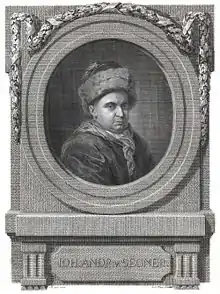Johann Andreas Segner
Johann Segner (Hungarian: János András Segner, German: Johann Andreas von Segner, Slovak: Ján Andrej Segner, Latin: Iohannes Andreas de Segner; October 9, 1704 – October 5, 1777) was a Hungarian scientist. He was born in the Kingdom of Hungary, in the former Hungarian capital city of Pozsony (today Bratislava).
Johann Andreas Segner | |
|---|---|
 Johann Andreas Segner's portrait | |
| Born | 9 October 1704 |
| Died | 5 October 1777 (aged 72) |
| Nationality | Hungarian[1] |
| Citizenship | Kingdom of Hungary |
| Known for | Segner wheel |
| Scientific career | |
| Fields | Mathematics |
| Institutions | Jena Göttingen Halle |
| Doctoral advisor | Georg Erhard Hamberger Simon Paul Hilscher |
| Doctoral students | Johann Georg Büsch |
Life
Johann Segner's ancestors came from Styria to Pressburg[2] in the Kingdom of Hungary; by the 18th century. He studied at Pressburg, Győr and Debrecen. In 1725 Segner began studying at the University of Jena. In 1729 he received a medical certificate and returned to Pressburg, where he started to work as a physician, as well as in Debrecen. In 1732 he returned to Jena for his master's degree. In 1735 Segner became the first professor of mathematics, a position created for him, at the University of Göttingen. In 1755 he became a professor at Halle, where he established an observatory.
Connections
One of the best-known scientists of his age, Segner was a member of the academies of Berlin, London, and Saint Petersburg. According to Mathematics Genealogy Project, as of February 2013, he has over 66 thousand academic descendants, out of the total 170 thousand mathematicians in the database.
Contributions
He was the first scientist to use the reactive force of water and constructed the first water-jet, the Segner wheel, which resembles one type of modern lawn sprinkler. Segner, also produced the first proof of Descartes' rule of signs. Historians of science remember him as the father of the water turbine. The lunar crater Segner is named after him, as is asteroid 28878 Segner.
Notes
- Pöss, Ondrej (2012). "Karpatskí Nemci". In Myrtil Nagy (ed.). Naše národnostné menšiny. Šamorín: Fórum inštitút pre výskum menšín. pp. 9–12. ISBN 978-80-89249-57-2.
- Segner biography
- Kaiser, W; Lengyel Z (November 1974). "[Cooperation in the history of science as illustrated on the example of the Halle-Hungary research on Johann Andreas Segner]". Zeitschrift für die gesamte Hygiene und ihre Grenzgebiete. 20 (11): 789–95. PMID 4619524.
- Kaiser, W (1977). "[Johann Andreas Segner (1704-1777)]". Zahn-, Mund-, und Kieferheilkunde mit Zentralblatt. 65 (3): 292–304. PMID 143166.
- Vissi, Z (March 1978). "[János András Segner]". Orvosi Hetilap. 119 (12): 725–6. PMID 345185.
- Foregger, R (September 2001). "The rotameter and the waterwheel". Der Anaesthesist. 50 (9): 701–8. doi:10.1007/s001010100196. PMID 11593877. S2CID 9922860.
Works in modern edition
- Johann Andreas Segner, Specimen logicae universaliter demonstratae (1740) edited with an introduction by Mirella Capozzi, Bologna: CLUEB, 1990.
